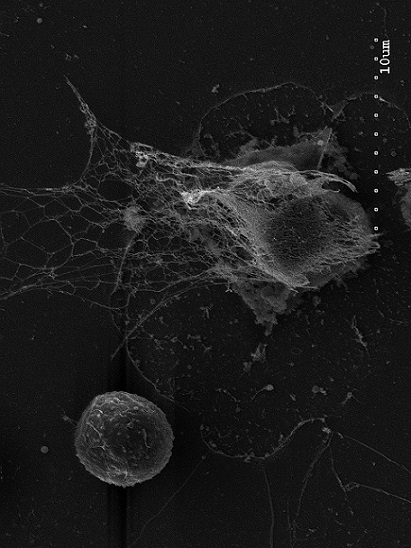Breast Cancer
Targeting the Tumor Microenvironment to Terminate Drug-Resistant Breast Cancer



Posted November 18, 2016
Mikala Egeblad, Ph.D., Cold Spring Harbor Laboratory
One of the most challenging obstacles for treating breast cancer is the development of metastatic tumors that have acquired resistance to therapies. While extensive research efforts have focused on the genetic changes within a tumor that confer resistance to therapy and lead to metastasis, results from these studies suggest that the process is more complex than originally thought. Recently, scientists found that conditions outside of the tumor cell, called the tumor microenvironment, can influence the spread of cancer cells. With support from a Fiscal Year 2013 Era of Hope Scholar Award, Dr. Mikala Egeblad is examining the impact of the inflammatory microenvironment on breast cancer metastasis and therapy resistance in hopes of developing novel therapeutic strategies for patients with metastatic drug-resistant tumors.

Mikala Egeblad, Ph.D., Cold Spring Harbor Laboratory (fourth from the right)
Photo provided with permission of Mikala Egeblad, Ph.D.
Neutrophils are an integral part of the innate immune system, killing harmful microorganisms through a variety of mechanisms, including the release of DNA-protein networks, called neutrophil extracellular traps (NETs), into the microenvironment. Outside of their traditional role, NETs have also been found to accumulate in tumors with as yet unknown contributions to drug resistance and metastasis. In a study recently published in Science Translational Medicine, Dr. Egeblad used a novel, live imaging technique developed in her lab, confocal intravital lung imaging or CILI, to observe the induction of NET formation by neutrophils in the absence of infection following the arrival of metastatic breast cancer cells to the lung. NETs were also observed in tumor samples from breast cancer patients, with higher NET levels being associated with the more aggressive triple-negative subtype. Through activation of neutrophil pathways involving nicotinamide adenine dinucleotide phosphate (NADPH) oxidase and peptidylarginine deiminase type 4 (PAD4) enzymes, metastatic breast cancer cells were found to stimulate the formation of NETs and alter the tumor microenvironment, resulting in increased tumor cell invasiveness. These results indicate that targeting NETs could be a promising new therapeutic strategy to prevent the development of life-threatening breast cancer metastases. DNase I, an enzyme that degrades DNA, can reduce the accumulation of NETs and is currently approved by the Food and Drug Administration in the treatment of cystic fibrosis. Using a mouse model of breast cancer that metastasizes to the lungs, Dr. Egeblad examined the possibility of targeting NETs by treating mice with DNase I-coated nanoparticles and found a significant reduction in the number of breast cancer metastases.

Neutrophil Extracellular Trap and Normal Neutrophil
Photo provided with permission of Mikala Egeblad, Ph.D.
Together, these results demonstrate a novel mechanism by which tumor cells alter the inflammatory microenvironment to escape detection and promote metastases. Moving forward, Dr. Egeblad is currently further examining how NET accumulation leads to tumor progression and therapy resistance in hopes of developing targeted treatments to prevent metastatic recurrence in patients.
Publication:
Park J, Wysocki, RW, Amoozgar Z, Maiorino L, et al. Cancer Cells Induce Metastasis-Supporting Neutrophil Extracellular DNA Traps. 2016. Science Translational Medicine 8, 361ra138.
Link:
Last updated Thursday, December 5, 2024














